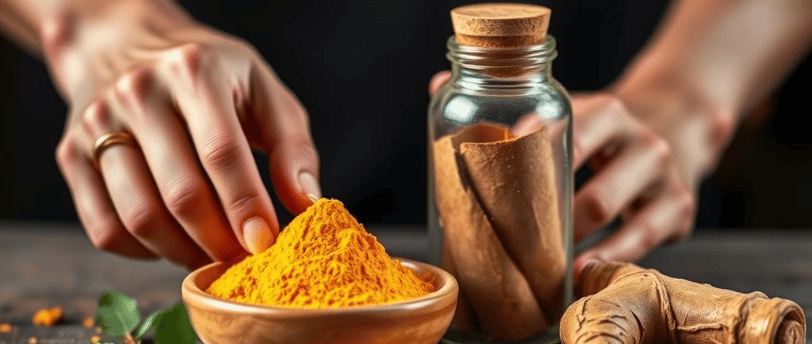Turmeric for Joint Pain: A Natural Anti-Inflammatory Remedy
JOINT AND MUSCLE PAIN


Joint pain affects millions worldwide, significantly impacting quality of life. While conventional treatments offer relief, many seek natural alternatives with fewer side effects. Turmeric, a vibrant spice commonly used in Indian cuisine, has gained considerable attention for its potential to alleviate joint pain. This article explores the scientific evidence surrounding turmeric's efficacy, different forms available, appropriate dosage, potential side effects, precautions, and delicious recipes to incorporate this potent spice into your daily routine.
The Science Behind Turmeric and Joint Pain
Turmeric's primary active compound is curcumin, a powerful antioxidant and anti-inflammatory agent. Chronic inflammation is a significant contributor to joint pain conditions like osteoarthritis and rheumatoid arthritis. Curcumin works by inhibiting inflammatory pathways in the body, reducing the production of inflammatory molecules like cytokines.
Several scientific studies have investigated turmeric's effectiveness in managing joint pain. A meta-analysis published in the Journal of Medicinal Food compared the efficacy of curcumin to nonsteroidal anti-inflammatory drugs (NSAIDs) in patients with osteoarthritis. The results suggested that curcumin was as effective as NSAIDs in reducing pain and improving function, with fewer reported side effects (Chandran et al., 2012). Another study published in Arthritis & Rheumatology found that a specific curcumin formulation significantly reduced pain and swelling in patients with rheumatoid arthritis, exhibiting comparable benefits to conventional medication (Chainani-Wu, 2003). These studies, amongst others, provide compelling scientific evidences supporting turmeric's potential role in managing joint pain.
Forms Available: Choosing the Right One for You
Turmeric is available in various forms, each with its advantages and disadvantages:
Powder: The most common and affordable form. Can be added to food, drinks, or used in capsules. Look for organic turmeric powder for the best quality.
Capsules/Tablets: Offer a standardized dose of curcumin, convenient for those who dislike the taste of turmeric. Bioavailability is a key consideration.
Liquid Extracts: Often combined with black pepper extract (piperine) to enhance curcumin absorption.
Topical Creams/Ointments: Applied directly to painful joints, providing localized relief.
Fresh Turmeric Root: Can be grated into dishes or used to make tea.
When choosing a turmeric supplement, consider the curcumin content and the presence of bioavailability enhancers like piperine. Due to curcumin's poor absorption in the body, look for formulations with enhanced bioavailability technology, such as liposomal curcumin or curcumin phytosome.
Dosage: Finding the Right Balance
The optimal dosage of turmeric for joint pain varies depending on the individual, the severity of their condition, and the form of turmeric being used. Generally, a daily dose of 500-2000 mg of curcumin is recommended, typically divided into multiple doses throughout the day.
Turmeric Powder: 1-3 teaspoons per day.
Curcumin Supplements: Follow the manufacturer's instructions, typically ranging from 500-1000 mg of curcuminoids per day.
It's crucial to start with a lower dose and gradually increase it to assess tolerance. Consulting a healthcare professional is always recommended to determine the most appropriate dosage for your individual needs.
Side Effects and Precautions: Exercising Caution
While generally safe, turmeric can cause side effects in some individuals, particularly at high doses. Common side effects include:
Digestive upset: Nausea, diarrhea, stomach cramps.
Allergic reactions: Skin rash, hives, itching.
Increased bleeding risk: Curcumin may have blood-thinning properties.
Precaution should be taken in the following instances:
Pregnancy and breastfeeding: Limited research is available, so it's best to avoid high doses of turmeric.
Gallbladder problems: Turmeric can stimulate gallbladder contractions and may worsen symptoms.
Bleeding disorders: Turmeric may increase the risk of bleeding.
Iron deficiency: Turmeric can interfere with iron absorption.
Medications: Turmeric may interact with certain medications, such as blood thinners and diabetes medications. Always consult with your doctor before taking turmeric, especially if you are taking any prescription medications.
Recipes: Incorporating Turmeric into Your Diet
Delicious recipes are the best options to incorporate turmeric into your daily routine:
Golden Milk: Combine 1 cup of milk (dairy or non-dairy), ½ teaspoon turmeric powder, ¼ teaspoon ginger powder, a pinch of black pepper, and honey or maple syrup to taste. Heat gently and enjoy.
Turmeric Smoothie: Blend fruits, vegetables, and a pinch of turmeric powder.
Turmeric Rice: Add turmeric powder to rice while cooking for a vibrant color and flavor.
Turmeric Curry: Turmeric is a staple ingredient in many curry recipes.
Roasted Vegetables with Turmeric: Toss vegetables with olive oil, turmeric, and other spices before roasting.
These recipes offer a palatable and convenient way to reap the benefits of turmeric.
Conclusion
Turmeric shows promise as a natural anti-inflammatory remedy for joint pain. While more research is needed to fully understand its long-term effects and optimal usage, existing scientific evidences support its potential to alleviate pain and improve function in individuals with osteoarthritis and rheumatoid arthritis. By understanding the different forms available, appropriate dosage, potential side effects, and taking necessary precautions, individuals can safely incorporate turmeric into their daily routine to manage joint pain and enhance their overall well-being. Remember to consult with a healthcare professional before starting any new supplement regimen.
References
Chainani-Wu, N. (2003). Safety and anti-inflammatory activity of curcumin: a component of turmeric (Curcuma longa). The Journal of Alternative and Complementary Medicine, 9(1), 161-168.
Chandran, B., & Goel, A. (2012). A randomized, pilot study to assess the efficacy and safety of curcumin in patients with active rheumatoid arthritis. Phytotherapy Research, 26(11), 1719-1725.
